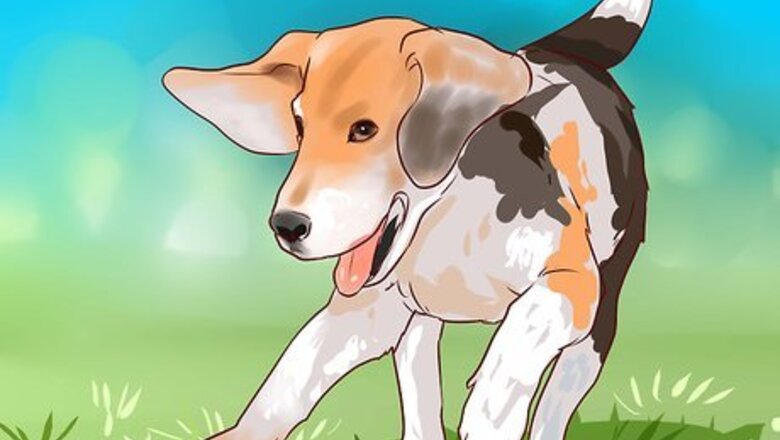
views
X
Research source
Positive Motivation

Expect an active temperament from your beagle. By nature, beagles are highly energetic and have a good sense of smell. They have descended from working dogs who used to follow scents during a hunt. This also means they tend to think for themselves, rather than rely on their owner to give directions. If your pet beagle won't be doing any hunting, training your dog is important. Beagles also like to use their voices and often bark when they get excited. Good training and plenty of exercise are key to prevent this becoming a problem. Commit to regular training sessions (at least twice a day), for as long as it takes to successfully train your beagle. Don't be discouraged, and don't give up!
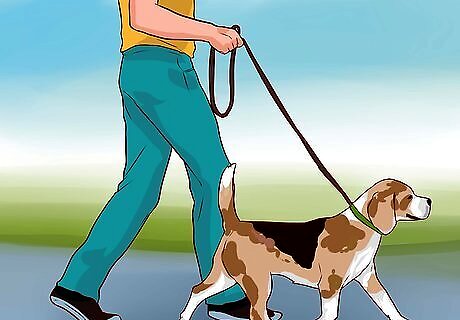
Take the lead and be patient. A beagle likes to think of himself as the leader, which is a recipe for disaster for the inexperienced dog trainer. You'll need to take a firm lead so that the dog believes he must follow your commands. Always use positive enforcement methods of training, instead of punishment. Your beagle's mind may also be elsewhere, so expect training a beagle to take longer than for other more easily influenced dogs like Labradors or Border collies.

Train your beagle throughout the day. Don't simply enforce commands only during training sessions. Your beagle will be more successful if you work with him on commands throughout the day. For example, you might insist that he sits before you put his food bowl down or sits at the curb before crossing a road. If the dog does not obey, do not do the activity. So, if he doesn't sit for the food, put it away. Get him to sit, then bring the food bowl out. If he refuses to sit at the curb, retrace your steps, then approach the curb and ask again. If you really need to cross the road and he still refuses, retrace your steps. Then, move forward and cross the road, but don't request your dog to sit.
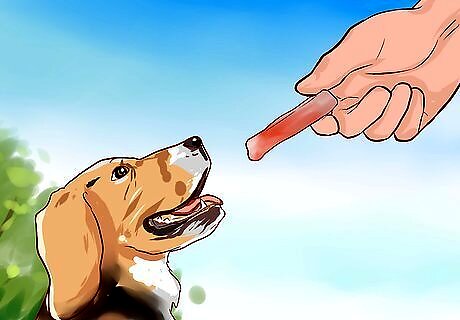
Motivate your beagle with food and praise. Food is a powerful motivator for beagles and some dogs are also highly motivated by attention and praise. Plan to use food rewards as part of your reward based-training, so that you give a treat immediately when the dog responds. As your dog starts responding on a regular basis, then give a reward every fourth or fifth success. Try giving your beagle high-quality commercial dog treats that contain few fillers. Or, you can also feed him cooked lean meats or baked potato, cut into small bites.
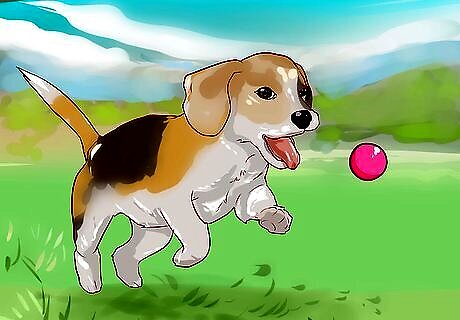
Exercise your beagle frequently. Since beagles are energetic dogs, it may be harder to teach them if they'd rather be running off than listening to your instruction. Try to take your beagle out for 1 hour twice a day, for some good running exercise. This will burn up some of his energy and make him more receptive to you as a teacher. You could play fetch or run with your dog on a leash. Remember that beagles are capable of running all day, so a 20-minute walk around the block twice a day won't exhaust your dog.
Basic Commands

Teach your dog to sit. Attract your beagle by holding a treat in your hand. Show him the treat, but don't let him have it. Instead, hold it just in front of his nose, holding it in between your finger and thumb. Once you have his attention, raise the treat so that the dog is forced to raise his nose. Arc the treat backwards so that when he follows it, his natural reaction is to sit. As he starts to move into sitting position, firmly say "sit" and give him the treat. Practice the "sit" command at every opportunity and in different locations, like at home in the yard, or on the street. This prevents tunnel vision where the beagle thinks he only has to respond if the command is given on his home turf. Eventually, your dog will respond to "sit" alone, without tracing the arc of the treat. Once he is doing this regularly, skip giving a treat. This builds uncertainty into the dog's mind so he doesn't take the treat for granted but works harder for it.
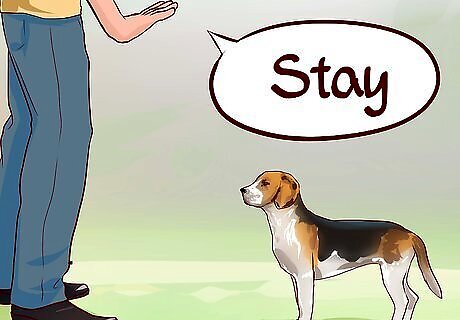
Train your beagle to stay. Your dog should be able to follow the sit command before you teach the stay command. Get your beagle in the sitting position. Hold up a hand like you're stopping someone and say "stay" in a firm voice. Your dog might only do this for a second or two, but you should give him lots of praise and keep practicing. Eventually, you can practice moving away from your dog while he stays.

Keep your beagle from jumping. There are several simple things you can try to keep your beagle from jumping up. If he successfully follows your requests, give him lots of praise. One method: you can ignore the jumping and walk away. Call him after a few minutes and give him lots of praise. Another method: you can use the stay command, followed by the sit command. If you suspect your beagle is jumping up out of boredom, consider schooling him. The behavior may stop while he's busy learning new things.
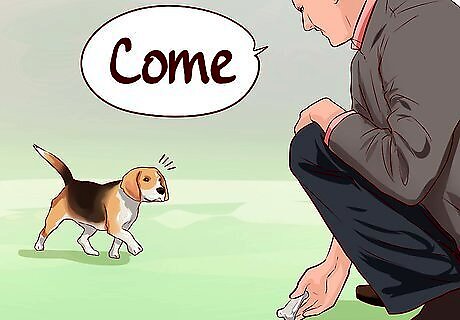
Teach your beagle to come. If the dog happens to approach you, say "come." If not, attract him closer with a treat. As he gets to you, repeat "come" and then praise him or give him a treat. Give your dog the time to complete the command. If your dog is taking a frustratingly long time to come, don't scold the beagle or snap the lead on and march your dog away. Your dog will associate the recall command with punishment. Once your dog has come to your side, instead of setting off straight home, give him his favorite toy and indulge him in a game on leash for a minute or two. That way he doesn't link the recall to punishment or an end to entertainment.
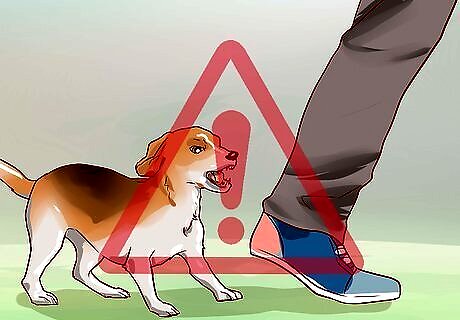
Keep your beagle from biting. If your dog bites during playtime, avoid playing aggressively or roughly with him. If he starts biting during a game, stop playing. Your beagle will soon figure out that biting ends the fun. Give your dog space and let him get comfortable around you before approaching him. If your beagle bites you or another person, it may be because he is afraid or doesn't trust you. Your dog may begin biting, but that doesn't mean he's a mean or aggressive dog. Your beagle may just be curious, playing, or defending himself. It's a good idea to teach your dog not to bite, regardless of what's causing him to do it.
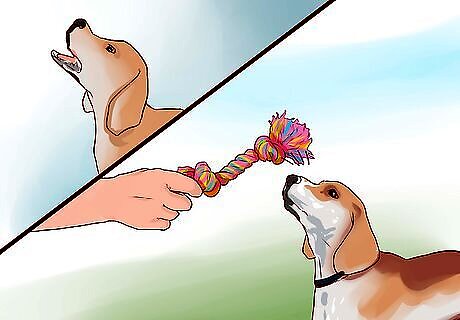
Anticipate your beagle's barking. Beagles often bark when they get excited or want to play. Unfortunately, this can be misunderstood by strangers as being aggressive or by other dogs as being overwhelming. When you're at home, learn to read your dog's facial expression when he is about to bark. He may look intensely focused, scrunch up his face, or begin to scowl. Pay attention to the unique face your dog makes before barking. When you see that expression, distract him. You can use the favorite chew toy to get his attention. With the barking interrupted, get your dog to sit and reward the good behavior. Sometimes, one recurring thing can cause your dog to bark: the doorbell, garbage trucks in the morning, the vacuum. Learn what causes your beagle to bark and then try to find a solution, either eliminating that thing or teaching your dog not to bark.
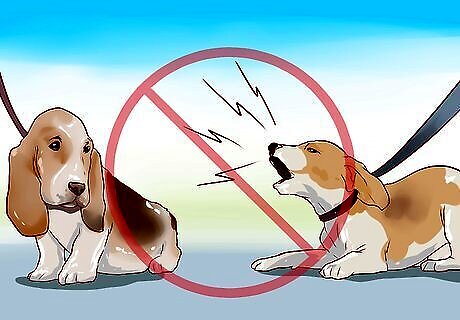
Teach your beagle not to bark at other dogs. Your beagle will most likely encounter other dogs when you take him for walks. To begin, keep your dog on a leash. When he sees a dog and starts to bark, say "quiet," then turn and walk in the opposite direction. Once the beagle has settled down, turn back towards the other dog. Keep repeating this, and eventually your beagle will learn that barking is counterproductive. If you're out walking your beagle and notice other dogs, don't tense up and worry about whether your dog will bark. Chances are, your beagle will be able to read your tension, which will also put him on alert, making it more likely that he'll bark.
Housetraining
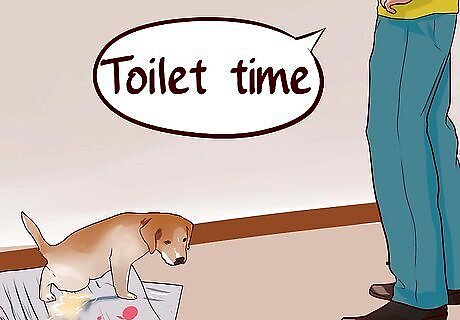
Set up a housetraining routine. Start as soon as you bring the dog home by setting him onto the toilet place. If he squats, say a cue word like, "business" or "toilet time." When he's finished, give him praise or a treat. Start by keeping the beagle in one room, so that he's not overwhelmed or distracted by a whole house of scents. Reward your dog immediately after he eliminates, so he associates the reward with the action.
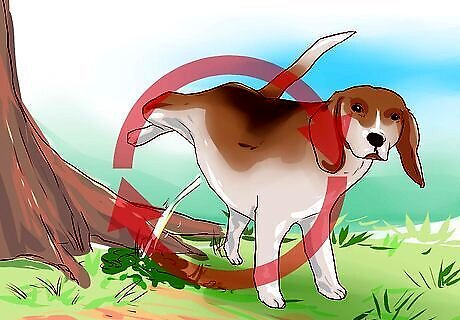
Be consistent. Try to take your dog outside to eliminate every 20 to 30 minutes, if possible. Choose a place outside to take your dog to relieve himself. Always return to this spot when you take him out to eliminate. You should also put him out first thing in the morning, last thing at night, and after eating. When he appears to squat, give him lots of praise. Since you're already outside, try rewarding your beagle with playtime in the park or a long walk.
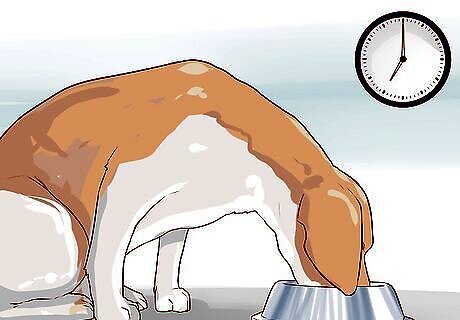
Feed your dog on a regular basis. The important thing is to set out food at designated meal times, instead of letting your dog graze all day. Plan several meal times throughout the day. With regular meals should come regular needs to eliminate. Take your beagle outside to eliminate 30 to 40 minutes after each meal. Plan your trips outside around meals and stick to the routine. Young beagles, will need to go outside more frequently. As a general rule, a puppy can wait 1 hour for each month of age it is, up to 8 hours. For example, a 3 month old puppy can wait 3 hours. The amount of food you give your beagle will depend on whether you're feeding dry manufactured food, meat, canned manufactured food, or making it yourself. Talk to your vet about a healthy beagle diet.
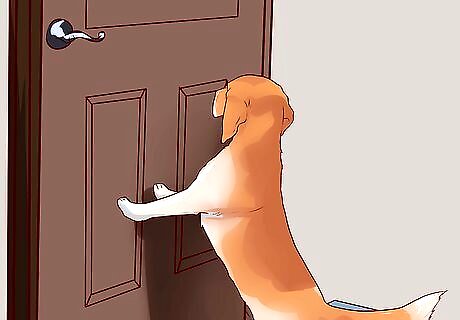
Watch your dog for signs. Your beagle will probably show signs that he's ready to eliminate. Pay attention to these and give him the opportunity to go outside before an accident can happen. Look for barking or scratching at the door through which you take your puppy out, squatting, restlessness, and sniffing around or circling. It's better to take your beagle out even if you're not completely sure he needs to go.
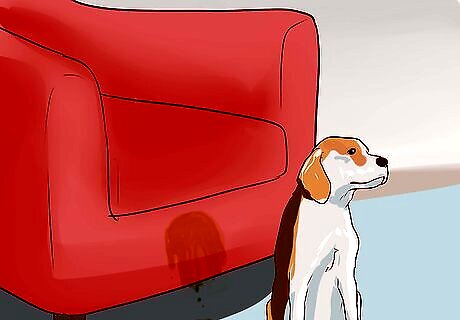
Be prepared to deal with accidents. If your beagle has an accident in the house, never scold or get angry with the dog. Once he has moved away, thoroughly clean the area with an enzymatic cleaner so there is no scent left to draw him back. Avoid general household cleaners which often contain bleach or ammonia. Ammonia is one of the components of urine. If you clean with it, you may actually make the scent signal or urine stronger which could make the beagle return to the wrong place to urinate. Do not leave cleaning products around the house that your dog can get into. Most of them are hazardous to health, so store them correctly.




















Comments
0 comment